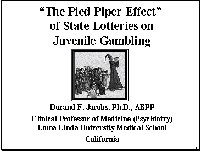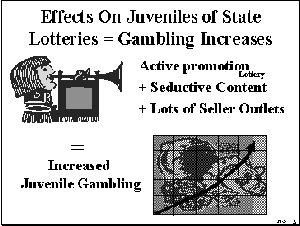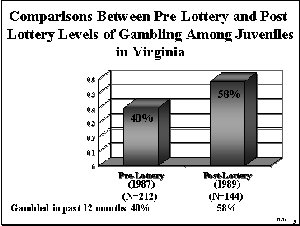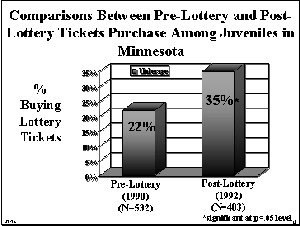4:00 P.M.
by Durand Jacobs Ph.D.
Assembly Room, A. K. Smiley Public Library
THE
LOTTERY AS "PIED PIPER" FOR JUVENILE GAMBLING
For more than the past twenty years I have
studied various health-threatening and risk-taking behavior in youth, including their age
of onset and subsequent involvement with
gambling.
In making this presentation, I shall wear
several hats. First, as a teacher and
clinician, concerned with the potential hazards that a government-supported lottery
may pose for legally underage juveniles in that state.
Second, as a social scientist, who has marshaled empirical data to
support his concerns. And finally, as an informed
citizen, attempting to understand how to prepare our children to become healthy and
productive citizens in a rapidly changing world scene, that has become virtually awash
with more forms of readily accessible legal and illegal gambling, than ever before in our
history.
Our focus today will be on state-supported
and promoted lotteries. At last count: 38 of them among our fifty states, and still more
eager to move out from the wings.
For openers (sic), I invite your critical
attention to the conduct of any given state lottery.
In its living form you will find it garbed in bright and colorful adornment,
strolling through streets of every neighborhood, surely a magical troubadour, leading
scores of happy followers on the road to easy riches.
(Parenthetically, riches thought to
be easy by the players, but riches known to be sure and easy by strapped state
legislators, who warmly welcome lottery revenues as a sure-fire, vote-getting,
budget-stretching alternative to raising taxes.)
Meanwhile, the siren song of this modern "Pied Piper" that urges adult players to "dream a little dream," inadvertently has caught the rapt attention of 12 to 17 year old juveniles. They are experts in dreaming dreams! In Technicolor, and with music! Especially dreams of instant riches, (wow,
wow), that mean no more need for school (oh yeah!); no longer need to prepare for
earning a living (my, my!); pay off the family home and send the folks off on a long
vacation (good, good!); world-wide travel (la,la!); a life full of recreation and
indulgence (whoopee!); and comfortable leisure to enjoy the later years (nice, nice!).
Quite a set of dreams to latch on to, Mr.
Piper Man. Oh, play it again and again for
me!
From the sidelines (egged on by lottery
supporters) comes a litany of protestations:
"What you say is terrible-it can't be
so!"
"On the back of each ticket it says,
'You must be 18 to play' "!
"Lottery ticket vendors can be
punished for selling to minors!"
“And the law says minors can be
brought to court for buying a ticket.”
“Can’t
be more than a very few kids, who buy lottery tickets.”
"Besides, playing the lottery isn't really
gambling. It's more like a church
raffle."
"Lottery earnings support good things, like education."
"Is there really any evidence to show
that lotteries have this so-called Pied Piper Effect
on kids?
That lottery play can even lead kids into greater involvement with other
forms
of gambling?"
"Nah!
Kids can't get into casinos, or bingo parlors, or race tracks; it's against the
law!
And kids betting with a bookie on sporting
events? Nonsense!"
In the fall of 2000 my second review of
juvenile gambling in North America was published. This
served to update and extend my original study of juvenile gambling, published in 1989. This first pioneering investigation, published in
1989, was received by some as a kind of expose of a phenomena that had existed for some
time, but had gone largely unnoticed by parents, school administrators, government
officials and the public media.
Of course, at that time everyone knew kids
flipped coins and, maybe, bet on their prowess in games of personal skill, like bowling or
darts. But everyone also remained confident
that kids simply couldn't wager on commercial games of chance: "Against the law!"; much less
consort with unsavory characters, like bookies.
Despite the latter publication of many
similar studies in the U.S., Canada, England, the Continent, Australia and New Zealand,
that largely replicated my earlier findings, people at large remain uneasy about accepting
facts that run counter to their personal beliefs about the limited nature and extent of juvenile gambling.
My fall of 2000 article on this subject
was titled, "Juvenile Gambling in North America:
An Analysis of Long Term Trends and Future Prospects." The Abstract, describing that study, read
as follows:
“Long term trends, based on findings
from twenty independent prevalence studies surveying middle and high school youth in
North America, suggest that within the past year two out of three legally underage youth
have gambled for money. In the United States and Canada as many as 15.3 million 12-17 year
olds have been gambling with or without adult awareness or approval, and 2.2 million of
these are experiencing serious gambling-related problems. Lottery play dominates legalized
forms of gambling among juveniles in both the United States and Canada. Trends between
1984-1999 indicate a substantial increase in the proportion of juveniles who report
gambling within the past year, and a parallel increase in the proportion of juveniles
reporting serious gambling- related problems. Yet, there continues to be little public
awareness or concern about the extent, or the potential hazards associated with juvenile
gambling. A composite profile of juveniles reporting numerous gambling problems is
contrasted with their peers who reported few or none. Future prospects concerning this
growing problem are offered.” (Italics added. Journal of Gambling Studies (2000),
16(2), 119-152.).
The results of this study left little
doubt that juveniles had long been old hands at gambling.
That a disturbing number of them, (as many as 1 in 7), were reporting three or more
serious gambling-related problems was eye-opening.
And that playing the lottery was one of their favorite bets, came as a surprise.
With your permission I will leaven my
continuing remarks with occasional excerpts from this article. The following is one of my favorite quotes:
"Games Played By Juvenile
Gamblers
“A consistent finding across all 20
studies of juvenile gambling in the United States and Canada is that minors (12-17 years
of age) have managed to penetrate and participate to some degree in every form of social,
government sanctioned, and illegal gambling available in their home communities and in
places where they travel. To the casual observer the range of these activities is quite
startling. It includes cards, dice, and board games with family and friends; betting with
peers on games of personal skill, such as pool and bowling; playing arcade or video games
for money, or for prizes; buying raffles tickets; sports betting with friends at school
or at off-track satellite betting parlors; wagering at horse and dog race tracks, and at
cock fights; gambling in bingo and card rooms; betting on jai Alai games; playing slot
machines and table games in casinos; buying pull tabs and lottery tickets;
playing at video lottery terminals; playing the stock market; wagering on the
Internet, and placing bets with a bookmaker. Naturally, communities will differ
regarding the local availability of one or another kind of gambling outlet.
“Notwithstanding local availability
of gambling opportunities, the four most popular games that emerge repeatedly from surveys
throughout North America are as follows: cards, dice and board game with family and
friends typically ranks number one among juveniles; games of personal skill with peers
tends to rank number two; sports betting, usually with peers in school settings, but also
with a bookmaker, ranks third; and bingo ranks fourth.
However, wherever a state or provincial lottery had been operative before the
prevalence study was completed, these government-promoted lottery games typically become
favored by juvenile gamblers. Indeed,
introduction of a state lottery always increases gambling among both adults and juveniles
in that jurisdiction, especially when pull-tabs, scratch cards, and other games that offer
instant reinforcement are accessible.
“After completing the first national
study on gambling in America, Kallick et al. (1976) concluded that, when a state promotes
one form of gambling, all forms of gambling, both legal and illegal, tend to
increase. To evaluate the effect of a
state-promoted lottery on juvenile gambling Jacobs (1994) completed a three state study. He found that in each state: (1) post-lottery
prevalence rates for juvenile gambling had increased significantly from pre-lottery
levels, (2) the lottery had become a favored
wager, when compared to other forms of gambling, and (3)
expenditures on other forms of gambling had increased from pre-lottery levels. Jacobs (1994) called this combination of factors
the "Pied Piper Effect." "

The presentation that follows will be in
the form of a "Talking Slide Show." I
may make a brief comment when introducing a new slide, but for the most part the
slides will tell my story.
The balance of my talk will address the three topics listed in "Today's
Agenda."
Effects on
juveniles of state-sponsored lotteries: smoking gun data
Rethink the
lottery as a fund-raising vehicle in light of product risk and safety issues
Consider product
safety impact on children - practical steps to lessen dngers.
Revisit policies
on state-supported advertising volume
Revisit policies
on state-endoresed advertising content
Revisit vendor
accountability.
I call your attention to my major thesis. Namely, that lottery advertising and easy
accessibility (1) lead children to wager on
lottery games, and (2) lead children to
expand and increase their wagering on other kinds of legalized, and still illegal,
gambling.

Now let's look at
what I call the "smoking gun" evidence, that supports my major thesis about the
influence of state lotteries on increases in juvenile gambling.



Recall the conclusions of Kallick et al
(1976) that stated, “when a state promotes one form of gambling, all forms of
gambling, both legal and illegal, tend to increase.”
I believe that what they found about the behavior of adult gamblers 30 years ago,
also applies to the behavior of today's juvenile gamblers.
Evidence portrayed below serves to support that position.



Of the 15 juvenile gambling prevalence
studies I reviewed in the United States, ten were completed in venues where a lottery had
been operating for some time before the study was initiated. In these venues the median level of juveniles, who
had gambled in a past year, was 66%.
No lottery had been operating in 5 of the
jurisdictions included in my review. In those
places the median level of juveniles, who had gambled in a past year was 52%. This finding supports my contention that the
presence of a lottery is strongly associated with increased levels of gambling among
juveniles, i.e. the "Pied Piper Effect."

We now may summarize
the "smoking gun" evidence regarding the several deleterious effects of
lotteries on the nature and extent of juvenile gambling.
The four spent "bullets" lined up in slide #12 lead one to conclude that,
indeed, state or provincial lotteries represent a product that is dangerous to some
juveniles, and may exert a harmful influence on their health and well being.
SUMMARY
Former rates of juvenile gambling increase
Jubeniles make lottery games a favorite
bet
Juveniles increase other forms of gambling
Juveniles spend more on gambling
The product is Dangerous to Juveniles And
Is Causing Harm
"Although no direct causal effect can
be shown between the operation of a lottery and a corresponding increase of gambling among
juveniles, the circumstantial evidence clearly points in that direction. Few would contest
the fact that the introduction and continuing advertising and promotion of a lottery
creates the most plentiful and locally accessible outlets for gambling. of legalized
gambling. The impact of this general climate of "it's O.K. to play" does not
escape the lottery tickets
a minor adventure which is very seldom discouraged by vendors, and which often is aided
and abetted by their parents and older relatives (Jacobs 1989a; Ladouceur & Mireault,
1988; Westphal et al., 1998; Winters et al., 1990).
Westphal et al. (1998),
following their statewide study of juvenile gambling in Louisiana, recommended strict
enforcement of existing age restrictions on lottery sales. They found that 65% of their
sample had played "scratch off " lottery tickets, as well as other lottery
games. Their data revealed that lottery play exceeded all other forms of licensed, as
well as social gambling. Volberg and Moore's (1999) replication study of juvenile
gambling in Washington State found a significant increase in juvenile lottery play between
1993 and 1999. This was found to be directly correlated with increased participation and
expenditures by these youth in other types of gambling, as well. Similarly, in
Canadian studies the lottery clearly prevailed as the favorite bet among juvenile
gamblers, including children in fourth through sixth grades (Gupta & Derevensky, 1996;
Ladouceur et al., 1994).
“The findings noted above support
Jacobs' (1994) earlier recommendations for restricting the
extent and the seductive content of
lottery advertising, rigorous enforcement of laws prohibiting
minors from gambling, and holding elected
officials and appointed lottery commissioners
directly accountable for contributing
(howsoever inadvertently) to juvenile gambling in general,
and to gambling-related problems among
juveniles in particular. The use of lotteries and other
forms of gambling by state and provincial
governments, as a major revenue-producing stream,
was
aggressively challenged." (p.126;
Italics added).
Thus,
-
Where lotteries
exist, and where they are being contemplated, state legislators and the affected public
must rethink the cost-benefits equation of this kind of revenue-raising vehicle in light of evidence revealing product
risk and safety issues affecting children.
-
Programs must also
be implemented and paid for from lottery Adminstrative Funds to address each of the
Product Safety issues specified in Slide 13. These
(1) fully eliminate the hazards of underage gambling; (2) provide preventive educational
services, explaining the potential hazards of gamblings;
(3) provide funding for training of therapists to help youth with gambling-related
problems on lottery products; and (4) support
research that may identify personal and situational risk factors that increase the
probability that children will become problem gamblers.
Steps To Improved Product Safety For
Children
Zero
Tolerance for underage gambling
Age
posting and policing of vendors
Reduce
advertising and "seductive" ads
Public
education about hazards
Free
800 Help lines
Training
of therapists
Funding
for treatment & research